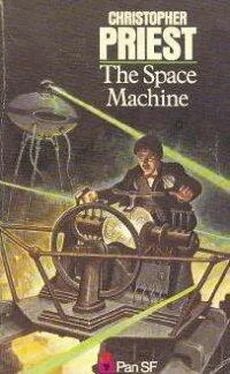It happened like this:
I had been experimenting with the panel that displayed the view before the ship, trying to understand the device whose nearest translation had been target. I had found that knobs could cause an illuminated grid-pattern to be projected over the picture. This was certainly in accord with target, for at the centre of the grid was a circle containing two crossed lines. However, beyond this I had not learned anything.
I turned my attention to the rearward panel.
In this, the view of Mars had changed somewhat while we slept. The reddish planet was now sufficiently far away for most of it to be seen as a disk in the panel, though still, because of the spinning of our craft, appearing to revolve. We were on the sunward side of the planet—which was itself reassuring, since Earth lies to the sunward of Mars—and the visible area was roughly the shape that one sees on Earth a day or two before a full moon. The planet was turning on its own axis, of course, and during the morning I had seen the great protruberance of the volcano appear.
Then, just as my watch declared the time to be nearly midday, an enormous white cloud appeared near the summit of the volcano.
I called Amelia to the controls, and showed her what I had seen.
She stared at it in silence for several minutes, then said softly: “Edward, I think a second projectile has been launched.”
I nodded dumbly, for she had only confirmed my own fears.
All that afternoon we watched the rearward panel, and saw the cloud drifting slowly across the face of the world. Of the projectile itself we could see no sign, but both of us knew we were no longer alone in space.
On the third day, a third projectile was fired, and Amelia said: “We are part of an invasion of Earth.”
“No,” I said, grimly lying to her. “I believe we will have twenty-four hours in which to alert the authorities on Earth.”
But on the fourth day another projectile was hurled into space behind us, and like each of the three before it, the moment of firing was almost exactly at midday.
Amelia said, with unassailable logic: “They are conforming to a regular pattern, and our craft was the first piece in that pattern. Edward, I maintain that we are a part of the invasion.”
It was then that my secret could no longer be maintained. I took her into the passages that ran the length of the ship, and showed her what I had seen through the sliding metal panel. The monsters had not moved, still slumbering peacefully while their flight to Earth continued. Amelia took her turn at the hole in silence.
“When we arrive on Earth,” she said, “we will be obliged to act quickly. We must escape from the projectile at the earliest possible moment.”
“Unless we can destroy them before we land,” I said.
“Is there any way?”
“I have been trying to think. There is no way we can enter the hold.” I showed her how the hatch had been fused. “We could possibly devise some way of cutting off their supply of air.
“Or introducing to it some poison.”
I seized on this solution eagerly, for since I had made my discovery my fears had been growing about what these creatures could do on Earth. It was unimaginable that they could be allowed to do their Devil’s work! I had no idea how the air was circulated through the ship, but as my command of the controls was increasing so was my confidence, and I felt that this should not be impossible to solve.
I had said nothing to Amelia of the slaves in their compartment—for I was by now convinced that there were many aboard—but I had done her an injustice when anticipating her reaction.
That evening, Amelia said: “Where are the Martian slaves, Edward?”
Her question was so forthright that I did not know what to say.
“Are they in the compartment behind ours?” she went on.
“Yes,” I said. “But it has been sealed.”
“So there is no possibility of releasing them?”
“None that I know of,” I said.
We were both silent after this exchange, because the awfulness of the wretches’ prospects was unthinkable. Some time later, when I was on my own, I went to their hatch and tried again to see if it could be opened, but it was hopeless. As far as I can recall, neither Amelia nor I ever referred directly to the slaves again. For this, I at least was grateful.
On the fifth day of our voyage a fifth projectile was fired. By this time, Mars was distant on our rearwards panel, but we had little difficulty in seeing the cloud of white vapour.
On the sixth day I discovered a control attached to the screens which could enhance and enlarge the images. When midday came around we were able to see, in relatively dear detail, the firing of the sixth cylinder.
Four more days passed and, on each of them the mighty’ snow-cannon was fired, but on the eleventh day the volcano passed across the visible portion of Mars,. and no white cloud appeared. We watched until the volcano had passed beyond the terminator, but as far as we could tell no projectile was fired that day.
Nor was there on the day following. Indeed, after the tenth projectile no more were fired at all. Remembering those hundreds of gleaming craft lying at the base of the mountain, we could not believe that the monsters would call off their plans with so comparatively few missiles en route for the target. This did seem to be the case, though, for as the days passed we never abandoned our watch of the red planet but not once again did we see any sign of the cannon being fired.
Of course, we occupied much time in speculating as to why this should be so.
I advanced the theory that this was the monsters’ plan: that an advance guard of ten projectiles would invade and occupy an area of Earth, for after all they would have an armoury of at least fifty battle-machines with which to do this. For this reason I felt our watch should be maintained, arguing that more projectiles would soon be following.
Amelia was of a different mind. She saw the surcease in terms of a victory for the Martian humans’ revolution, that the people had broken through the monsters’ defence: and taken control.
In either event we had no way of verifying anything other than what we saw. The migration had effectively finished with ten projectiles, at least for the time being.
By this time we were many days into our voyage, and Mars itself was a small, glowing body many millions of miles behind us. Our focus of interest was moving from this, for now, in the forwards panel, we could see our homeworld looming towards us: a tiny crescent of light, so indescribably lovely and still.
Asthe weeks passed I became more at home with the controls, feeling that I understood the function of most. I had even come to understand the device the Martians had called the target, and had realized that it was possibly the most important of all the controls.
I had learned to use this when viewing Earth through the forwards panel. It had been Amelia who had first pointed out our world: a clearly defined brilliance near the edge of the panel. Of course, we were both much affected by the sight, and the knowledge that every day carried us thousands of miles nearer to it was a source of steadily growing excitement. But as one day followed another, the image of our world slipped nearer and nearer to the edge of the display, until we realized that it could not be long before it vanished from our sight altogether. I adjusted the controls of the panel equipment to no avail.
Then, in desperation, Amelia suggested that I should turn on the illuminated grid that was projected across the panel. As I did this I saw that a second, more ghostly grid lay behind it. Unlike the main one, this had its central circle fixed on the image of our world. It was most uncanny … as if the device had a mind of its own.
Читать дальше











